If you’re on the hunt for a charming addition to your Monstera collection, look no further than the beautiful and delicate Monstera adansonii. Also commonly called the Swiss Cheese Plant or Monkey Mask, the adansonii looks a lot like its big cousin, the Monstera deliciosa. However, the key difference between the two is the former’s more diminutive stature and inclination for trailing vines.
In terms of appearance, the heart-shaped, textured, fenestrated leaves of the adansonii are bright, dark green. While this gorgeous plant is sometimes (incorrectly) palmed off as a Monstera obliqua, it is closer in appearance to the deliciosa, just on a much smaller scale and with denser growth patterns.
In good news, the adansonii is just as low-maintenance and easy to care for as most of the Monstera in the Araceae family. It grows quickly, making it a showstopper in the home, and can be trained to trail or climb along structures, moss poles, or trellises.
If you’re lucky enough to have obtained one of these specimens, or you’re considering purchasing one, you’ve come to the right place. In this article, we’ll look at everything you need to know about Monstera adansonii care. Ready? Let’s jump right in.

Table of Contents
How do you take care of Monstera adansonii?
Because Monstera adansonii are tropical plants, they do best in environments that closely emulate their natural habitats. This means ensuring they have plenty of warmth and humidity and consistent access to water. Supplemental feeding with a nutrient-rich fertilizer is also beneficial as is providing bright, indirect light.
One of the reasons Monstera are so popular the world over is because they are easy to care for. The same is true for the Monstera adansonii. With this beauty, all you need to do is ensure its basic needs are met, and it will reward you with gratifying growth and a healthy appearance.
Whether you’re buying your adansonii from a store or growing it from a propagated cutting, there are a few fundamentals to keep in mind. For one, you want to ensure your Monstera is planted in quality soil from the get-go. As these plants can be susceptible to root rot, well-draining, aerated soil is a must.
In terms of light, it’s good to remember that, at the heart of it, Monstera are jungle-dwellers. Generally, they live and grow in the shade of bigger trees and plants, surviving off the sunlight that breaks through the canopy of the forest. Direct sunlight can harm or scorch their leaves, so it’s best to keep them in indirect warmth.
As for replicating the nutrient-rich substrate of rainforests, this is a more challenging task in the home. Consequently, it is advisable to mix your soil with moss or bark for extra organic matter and to occasionally feed your Monstera with a bit of fertilizer for extra nutrition.
Are Monstera adansonii easy to care for?
The Monstera adansonii is very easy to care for and requires no expert knowledge. Adequate light, water, humidity, and fertilizer, as well as good-quality soil, will place you on the road to success. In addition to this, the adansonii is not prone to ill health or pests – although it can suffer from root rot if overwatered.
Should you notice any signs of distress (such as foul-smelling soil, drooping, pests, or yellow leaves), the good news is that adansonii problems can be easily rectified. Once you’ve deduced the cause of the issue, be it irregular watering, infection, or malnutrition, you can usually solve it quickly and easily with improved living conditions.
At worst, your adansonii may require some pruning and potentially repotting. Still, ultimately these are good practices for Monstera adansonii care and, in any case, will encourage growth over time and keep your plant healthier for longer.
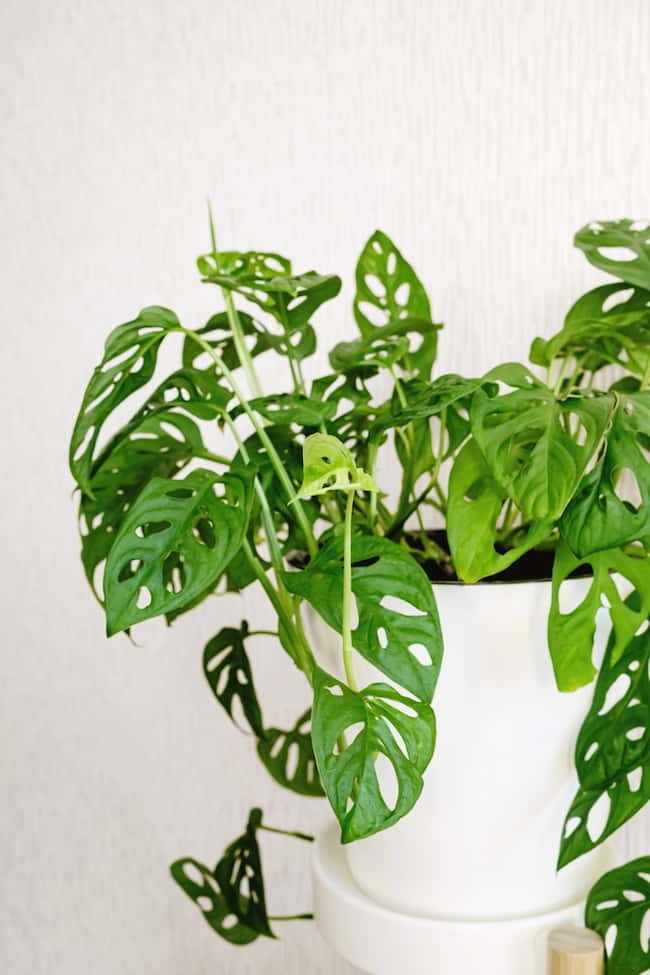
Is Monstera adansonii an indoor plant?
The Monstera adansonii is an extremely popular indoor plant, beloved by collectors all over the world. Its resilience, ease of care, and lacy, delicate look make it a definite fan favorite for Monstera enthusiasts. Like most species in this genus, it’s green all year round and, therefore, a great statement plant for the home.
This plant is not particularly fussy and can live and thrive in a wide temperature range, so it’s also very adaptable. Even without full indirect light all day (and the occasional missed watering session), the Monkey Mask will carry on, just perhaps not at the ideal Monstera adansonii growth rate.
Is Monstera adansonii rare?
Monstera adansonii are not among the rare varieties of this genus. In fact, they can usually be purchased directly from nurseries or garden centers and even the occasional grocery store. The reason for their increased popularity is that they are easily propagated and consequently widely available.
There is some confusion in the plant world about how easy it is to get your hands on one of these gorgeous specimens. And the easy explanation is that the adansonii is often confused with the Monstera obliqua, which is an extremely rare and scarce Monstera variety.
While they are similar in appearance, there are clear distinguishments between the two once you’re familiar with the Monstera family. As they reach maturity, the Monstera obliqua becomes increasingly fenestrated to the point that it is essentially more negative space than leaf (up to 90%). At a young age, however, these plants do look undeniably similar.
Nine times out of ten, if you see a Monstera at a local nursery marked as obliqua, you’ll be purchasing an adansonii that is incorrectly marketed. The flipside of this is that the adansonii has unintentionally earned a reputation for being rare.
In truth, the adansonii is easy to come by and propagates exceptionally well. These days, you could probably grab a cutting from a giving friend or neighbor and end up with your own flourishing adansonii in no time.
Why is Monstera adansonii expensive?
Monstera adansonii are not particularly expensive (generally ranging from $10 to $30), especially as they are becoming more freely available and popular. That being said, a variegated adansonii can be astronomically priced, with one recently fetching $38,000 at auction.
While the adansonii is not yet as commonly found as the deliciosa, for example, it is no longer a scarce commodity either. For the most part, the Monstera adansonii price is reasonable, and they can be found worldwide in nurseries and other shops. Where they get expensive is when they show signs of variegation.
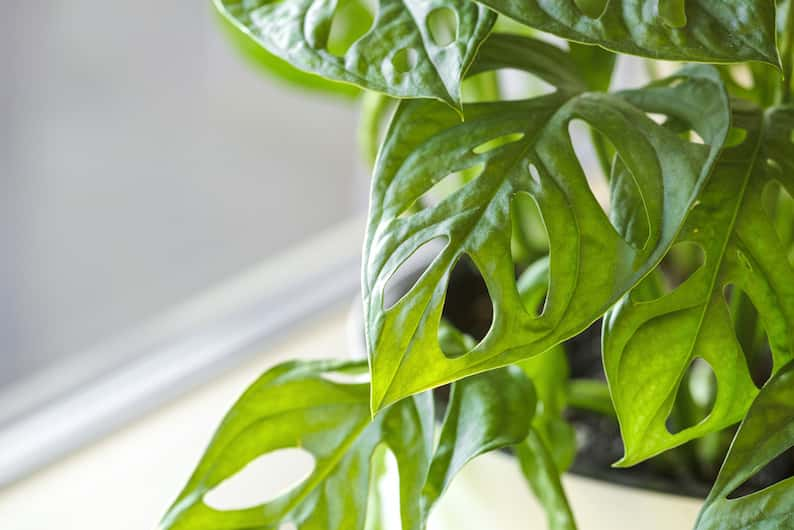
Globally, variegated Monstera are highly sought-after, and a variegated Monstera adansonii is no exception. Very seldom will a dappled or bicolored adansonii turn up for auction, and when it does, it will bear a hefty price tag and ultimately end up with only the most serious of collectors.
But, if you’re in the market for a regular green adansonii, you’re in luck. You won’t find yourself paying much more than you would for any other common Monstera houseplant, depending on the size and maturity of your chosen plant.
Is Monstera adansonii a Monkey Mask?
Monstera Monkey Mask is a common nickname for the Monstera adansonii and derives from its distinct fenestrations. Where the deliciosa and other popular Monstera have split leaves that look as though they’ve been cut, the adansonii typically has apertures closer to its leave’s central veins.
If you hear someone referring to a Monkey Mask, the chances are high they’re referring to the Monstera adansonii. Where the moniker Swiss Cheese Plant is often used interchangeably between Monstera species, the title Monkey Mask seems to be reserved more specifically for this breed.
While the source of this nickname’s origin story is unclear, it is widely believed that the term Monkey Mask came about when a monkey found itself trying to use an adansonii leaf as shelter. Due to the plant’s distinct fenestrations, the leaf provided little in the way of disguise, and thus the term Monkey Mask was born.
How often should you water Monstera adansonii?
Monstera adansonii require regular watering, usually once per week. They are tropical plants, so they need a fair amount of moisture, but not to the degree that their soil becomes soggy. Watering may also need to be adapted according to the weather, with more needed in the hotter months.
When it comes to indoor Monstera in relatively regulated home environments, a good rule of thumb is to water them once every 7 to 10 days. However, this is just a ballpark estimation and depends on a few factors, including the size of your adansonii and its planter, temperature, and how much humidity they receive.
With adansonii, it’s best to find a good balance of keeping them moist so that they can draw nutrients from the soil while being careful not to drown them. Adansonii don’t do well with “wet feet” and are inclined to develop root rot if they’re left in soggy soil for long periods of time.
To prevent root rot in your Monstera, it’s best to check your soil with a fingertip instead of necessarily sticking to a stringent watering regime. Once the top inch of soil is dry, you can top up your adansonii, making sure not to let it stand in pooled water in its drip tray. Alternatively, you can invest in a moisture meter that will tell you when your soil’s dampness is running low.
Monstering adansonii watering is a crucial part of its care, and these beauties will act out if they’re unhappy with the moisture levels in their soil. In the following sections, we’ll look at what happens when your adansonii gets too thirsty, as well as how to improve their hydration intake.
How do you know when Monstera adansonii needs water?
If a Monstera adansonii needs water, there are several clear indicators of this, the most obvious of all being drooping or yellowing leaves. While these symptoms can indicate numerous issues, the most common is dryness. To confirm your diagnosis, feel your adansonii’s soil. If it’s loose and dry, it’s time for water.
Trust me. If a Monkey Mask needs water, it will let you know. Fortunately, when those signs of underwatering start to appear, you can solve this conundrum with a hearty dose of H20.
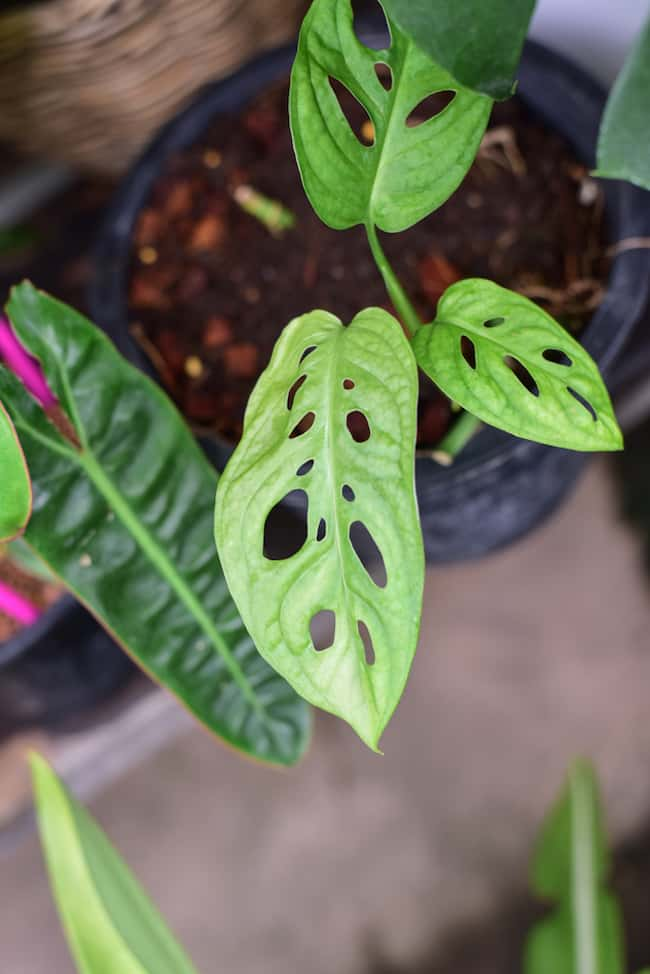
While adansonii are resilient, it must be said that it’s not a good idea to repeatedly let your Monstera dry out to the point that they start to wilt. This causes irreversible damage to their leaves over time, resulting in an unkempt appearance. Additionally, dried leaves waste your plant’s energy, as they will only continue to deteriorate.
As a side note, a Monstera adansonii’s yellow leaves can also be a sign of overwatering, which in turn leads to rotting roots. To diagnose the same, you can also feel your plant’s soil. If it is dense and wet, you should hold off on watering. It may also take on a foul odor once infection sets in.
Related: Exactly How Often to Water Your Monstera
Do Monstera adansonii like to be misted?
Monstera adansonii love a good misting, which, when undertaken regularly, is beneficial for keeping them moist and upping their humidity intake. These gorgeous jungle plants do best in environments with 50% to 60% humidity, superseding the levels generally found in an indoor home setting (30% to 50%).
Aside from the obvious perk of emulating their natural environments, misting also goes a long way to keeping an adansonii looking its best. The leaves of these plants contain tissue cells that function at their optimal level when they have access to a bit of moisture. Furthermore, added humidity prevents your Monstera’s aerial roots and delicate stems from drying out and drooping.
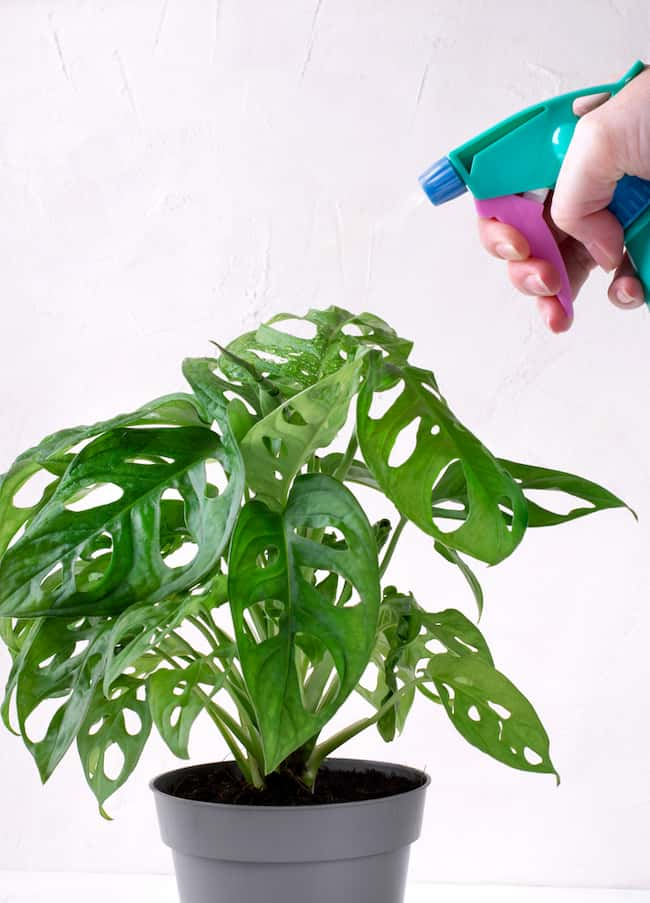
How do you train a Monstera adansonii?
You can train adansonii to climb various structures. They are viners genetically designed to seek out bigger plants, like trees, to shelter against. Preparing them to grow in a specific direction entails providing them with a support, like a moss pole, to which they can attach their aerial roots.
Most of the plants in the Monstera genus are epiphytes, which means they possess both aerial and ground roots. Like many tropical vining plants, adansonii like to take shelter against larger trees, attaching themselves and growing up towards the forest canopy, searching for the sun. Indoors, they also attach themselves to various supports as a means to reach greater heights, with their natural inclination being to grow upwards.
Given this, if you intend to train your Monstera adansonii to climb, you’ll need to put measures in place to allow it time and room to attach. One of the best structures for this purpose is giving your Monstera adansonii a moss pole or a coco coir pole, as this substrate has a similar texture to bark, allowing them to grip it effectively. If this is not your taste, they can also be trained to climb along a trellis.
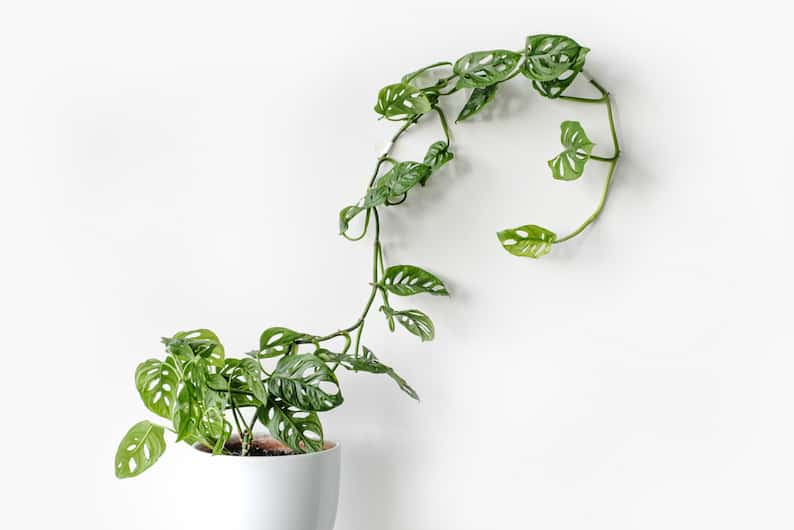
Initially, you may need to offer your Monstera a helping hand in the form of florist’s tape, twine, or clips, to allow it time to settle and develop its rooting system. As new growth springs forth, you can manipulate it gently to grow around the pole rather than straight up. In a few weeks, it should be able to hold its own and will continue to root upwards. The taller your adansonii gets, the larger its leaves will become.
Indeed, there is no hard and fast rule stating that Monstera adansonii need to climb, although it is in their instinct to do so. As an alternative, a trailing Monstera adansonii in a hanging basket can look spectacular as you let their beautiful leaves drape downwards.
How fast does adansonii grow?
The Monstera adansonii growth rate depends significantly on its living environment, but in ideal conditions it can grow an impressive 1 to 2 feet (30cm to 60cm) per year. Its most prolific growth is during the warmer months, from spring to early autumn, after which it enters a slow or dormant phase.
If you’re looking for a plant that will treat you with plenty of new leaves on your Monstera on a regular basis, the adansonii is for you. This treasure is famous for its growth and really gets going when it has the opportunity to climb, stopping only when it has reached the top end of its support. For this reason, a Monstera adansonii moss pole may need regular replacing or extending.
During spring, through summer, and all the way into early autumn, Monkey Masks experience spurts of growth every few weeks, expanding exponentially. As temperatures drop, they will start to grow more slowly, even halting altogether, depending on how cold it gets. Needless to say, once the sun comes back, they’ll bounce back in full force.
If you’re worried your adansonii isn’t growing fast enough, there are a few steps you can take to encourage more rapid production, including supplemental feeding and pruning. Funnily enough, pruning your Monstera makes way for new growth and redirects your plant’s energy away from old, decaying leaves and stems. So, don’t think of it as minimizing your plant, but rather as a rejuvenation tactic.
The growing season is the best time for pruning a Monstera adansonii, as it will have plenty of energy from the sun and warmth. It’s also the ideal time for training your Monstera plant to climb or for repotting it if necessary.
How big do Monstera adansonii grow?
In the wild, Monstera adansonii are known to reach up to 12 feet (3.6 meters) or bigger, but indoors they generally only grow to be between 3 to 5 feet (1 to 1.5 meters). This is, of course, provided they have excellent living conditions and preferably a structure to support them.
The Monstera adansonii is by no means a giant Monstera plant. Indeed, it is one of the smaller plants in the Araceae family. Even so, it can become quite large for a house-dweller, with mature specimens growing up to 5 feet (1.5 meters tall).
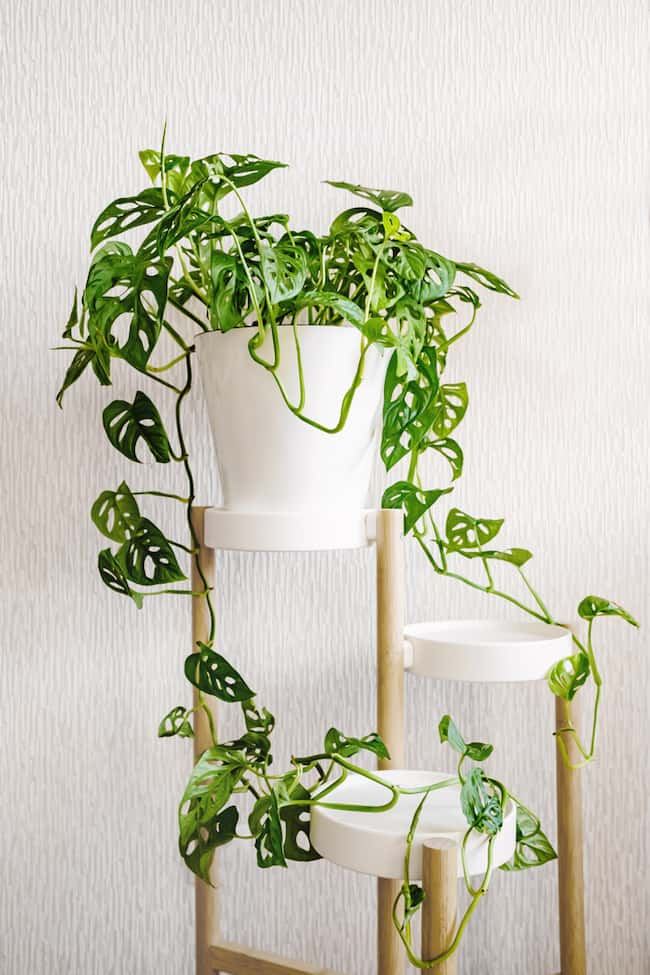
In their natural habitats, adansonii have more space to spread themselves out and an almost endless supply of rich nutrients from the soil, as well as from the trees they love to climb against. They will always grow up toward the forest canopy but prefer not to come into direct contact with the sun, as at that point they prefer to look for shady shelter instead.
It must also be noted that two things will directly impact how big an adansonii grows, namely season and planter size. Don’t be alarmed if your adansonii sees no new growth during winter. This is perfectly normal, and the plant is simply dormant.
In terms of planter size, a Monstera’s development can become stunted if it is rootbound, so poor growth in the warm months may indicate that your adansonii needs to be repotted into a roomier space.
Related: Here’s the Best Pot for Your Monstera
How do I get a bigger leaf on Monstera adansonii?
The best way to encourage bigger leaves on a Monstera adansonii is to provide it with a structure to climb and ensure it has plenty of water, light, and humidity. Happy, healthy plants tend to grow larger leaves when they have plenty of energy and nutrients to do so.
To get sizeable leaves on your Monstera, do a once-over of its environment to see what you can improve. Does it have a climbing pole? Have you fertilized it recently? Do you regularly moisturize its leaves through misting?
All these small care measures create a better quality of living for your plant and allow it room to flourish and thrive by default.
What soil is best for Monstera adansonii?
A Monstera adansonii needs an aroid soil mix that is well-draining and moisture retentive. A good adansonii mixture contains perlite for retaining moisture, bark or moss for aeration and nutrients, and charcoal for balancing pH levels. You can purchase soil pre-made or mix it yourself.
Good soil for your Monstera is one of the fundamentals of proper plant care, so save yourself a lot of heartache by getting this right from the start. Usually, if you buy an adansonii from a supplier, nursery, or garden center, the presumption is that it is already housed in appropriate soil. However, if you’re growing an adansonii from a cutting, the onus is on you to ensure you have the right ground mix for your new baby.
If you can’t get your hands on a specialist Monstera soil, you can mix your own by combining perlite, bark, moss, or even coco coir and a bit of activated charcoal. Aerating your soil with chunkier bits of moss or bark prevents it from suffocating your adansonii’s roots while simultaneously providing nutrients. Charcoal keeps your pH levels in a slightly acidic range of 5.5 to 7.0. Perlite retains water while also aiding drainage by trapping air and expanding, allowing excess moisture to filter out.
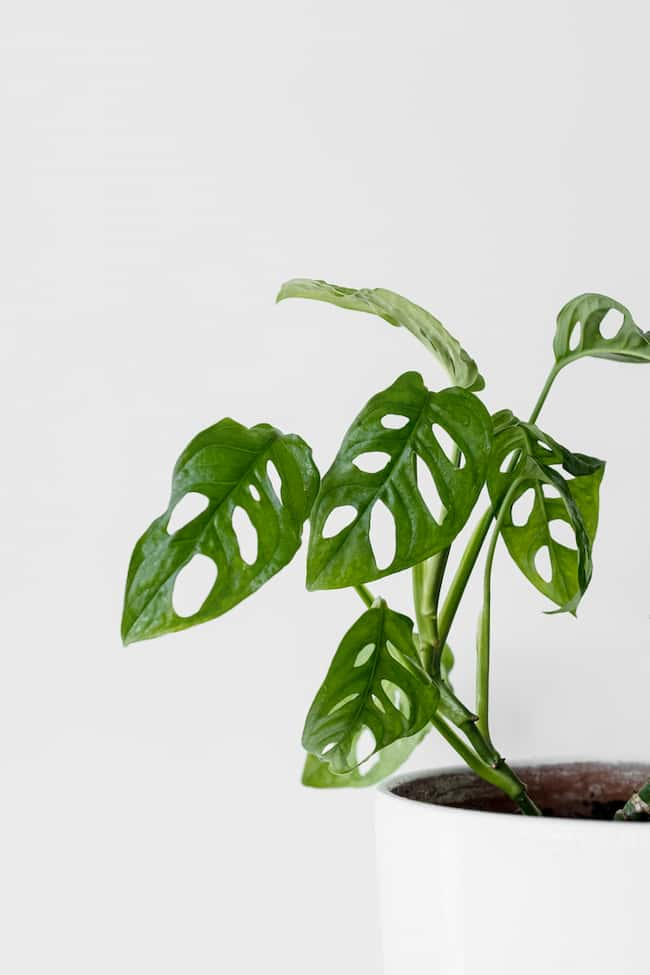
How to deal with Monstera adansonii root rot
One of the biggest challenges facing houseplant owners is root rot, which can be devastating if not treated timeously. Fortunately, if caught early enough, root rot can be dealt with by eradicating the infection through repotting your Monstera and pruning away infected plant tissue.
If you’re inspecting your adansonii regularly for signs of distress, you should be able to identify potential root rot quite quickly, but immediate action must be taken to curb the spread of this disease on your Monstera. Let’s look at the steps you can take to treat and deal with root rot.
- Inspect your adansonii’s root ball – Once you have established that your Monstera adansonii has contracted root rot, your first step is to gently remove it from its planter and inspect its root ball. Isolate roots that have taken on a yellow, brown, or black appearance and prepare to cut them away.
- Use clean tools to prune away infected areas – This point is so crucial that it’s worthy of its own bullet point. When pruning any plant, always make sure your tools are clean and sterilized. If not, you risk spreading the root rot infection to other plants or to healthy sections of the plant you’re working on. On this note, Monstera adansonii droopy leaves should also be pruned away, as they’re unlikely to recover.
- Work carefully and avoid overhandling your plant – While adansonii are inarguably resilient, they can still undergo transplant shock, so when pruning your roots, make sure to handle your plant as sparingly as possible. In particular, try not to damage healthy roots.
- Clean and disinfect your planter – After the trauma of having to operate on your adansonii’s root system, the last thing you want is to return it to the site of infection. For this reason, it is pertinent that you scrub and disinfect its pot or transplant it into a new planter altogether. If you’re cutting away a substantial portion of your Monstera’s roots, you may even need to opt for a slightly smaller housing.
- Replace your adansonii’s soil – Root rot is a bacterial or fungal infection that lives in soil, so it follows that you would need to replace your potting mix to get rid of the disease altogether. When replanting your Monstera, make sure you select an appropriate, nutrient-rich soil mix.
- Adjust your watering habits – Most of the time, when Monstera contract root rot, it is because they have been overwatered, or they’re receiving too little light or a combination of the two. Once your plant is pruned and repotted, part of your aftercare regime is to monitor your watering habits to make sure your soil doesn’t become soggy. Only water your adansonii when its top layer of soil is dry. Furthermore, ensure it has access to 6 to 8 hours of bright, indirect light daily.
Most plants in this genus are pretty susceptible to root rot, which generally results from overwatering your Monstera. It is seldom intentional but instead a consequence of poor soil drainage leading to an overly moist environment that becomes a fungal or bacterial breeding ground. Combine this with poor access to light, and the writing is on the wall.
Symptoms of root rot include yellowing leaves, drooping, stunted growth, and a damp-smelling, foul odor. If root rot is indeed the cause of your Monstera’s ill health, you should be able to easily diagnose it by feeling your soil. If it is water-logged and soggy, the chances are high that your plant is infected.
Monstera adansonii light needs
In their natural environments, Monstera adansonii rely on bright but indirect sunlight that filters through the canopies above them. Indoors, they do best with 6 to 8 hours of indirect sunlight daily. The best position for them in a home is close to a North- or South-facing window.
What makes Monkey Masks such wonderful houseguests is the fact that they aren’t too fussy when it comes to their lighting needs. They can survive and thrive in spaces that receive bright but indirect light, with no real need to be too close to windows, as long as the area is illuminated for most of the day.

Indeed, too much sun can actually be damaging to them, as direct sunlight tends to scorch their lacy leaves. Six feet away from a bright window is more than adequate, provided the area is relatively humid. If you notice your Monstera adansonii leaves turning yellow, dry and crispy, they’re likely too close to the sun.
That being said, adansonii won’t fare too well in areas that are dark or dimly lit either, so if you notice slowed growth or yellowing leaves unrelated to your watering practices, consider moving your Monstera to a sunnier spot.
Related: Monstera Light Requirements: How Much Does It Need?
Monstera adansonii varieties
Several varieties of Monstera adansonii exist under one umbrella term. For example, the classic Monstera adansonii comes in both a narrow and a wide form, whereas variegated adansonii have striking, bright white patches. Indeed, the ever-elusive Monstera obliqua is also a species of adansonii.
Generally, when people refer to the Monstera adansonii, they think of the easy-to-find, glossy green creeper adorning the homes of thousands of houseplant enthusiasts. In truth, adansonii come in many shapes and forms – literally. Different cultivars also present with different hues and aperture sizes in their fenestrations.
One example is the Monstera Laniata, which is actually a subspecies of the adansonii. Because of this, the two have many similarities, although it’s also a classic example of how the fenestrations can differ between different varieties.
Monstera adansonii variegata
A truly special sight to behold is the incredibly rare variegated Monstera adansonii. Resulting from a genetic mutation, this specimen can be identified by its bright white stripes or patches, which often cover up to 70% of a leaf. The white areas on these plants are spots completely lacking in chlorophyll.
Variegated adansonii are spectacularly rare and go for exorbitant prices when they do become available. They’re also tricky to care for, as they do not draw in sun energy as effectively as their fully green counterparts.
Monstera adansonii wide form
While all adansonii have oval-shaped leaves, they do come in a wide and narrow form. Wide form Monstera adansonii can be identified by their thicker stems and rounder leaves, whereas narrow-form adansonii have thin vine-like stems and slightly more elongated leaves.
How can you tell the difference between Monstera deliciosa and adansonii?
The main difference between a Monstera adansonii vs Monstera deliciosa is that a deliciosa’s leaves are much larger, as is the plant overall. Their fenestrations also differ in that the deliciosa is split to its edges, whereas an adansonii tends to have numerous holey apertures close to the central vein of its leaves.
In actual fact, the Monstera deliciosa and adansonii don’t really look that similar at all, especially compared to, say, the Monstera acacoyaguensis. The confusion tends to arise because they’re both very popular, better known Monstera varieties, so it’s more about perhaps being aware of them without knowing what each type looks like.
Once you see them in person though, there shouldn’t be any misunderstanding in identifying them.
How to propagate Monstera adansonii
Monstera adansonii are easy to propagate from cuttings placed in water. All you need is to select a healthy cutting in possession of a few leaves and at least two nodes, leave it in water in a sunny spot, and wait for new growth to emerge. Once it has rooted, you can transplant it into a soil mix.
Mad about your Monkey Mask plant and so looking for how to propagate Monstera adansonii? Fortunately, Monstera adansonii propagation is easy, and you can enlarge your collection by rooting Monstera cuttings in water. These gratifying plants are fast to multiply, provided you select a healthy cutting and practice a few weeks’ worth of patience.
In summary, all you need to do is snip off a stem cutting with clean, sterilized tools, and pop it into a container with fresh water. Your cutting should have two healthy nodes minimum, as this is where your new roots will form. In four to six weeks, you should be able to transfer your new plant into soil. And just like that, you would have successfully propagated your adansonii.
Related: How to Propagate Monstera: The Ultimate Guide
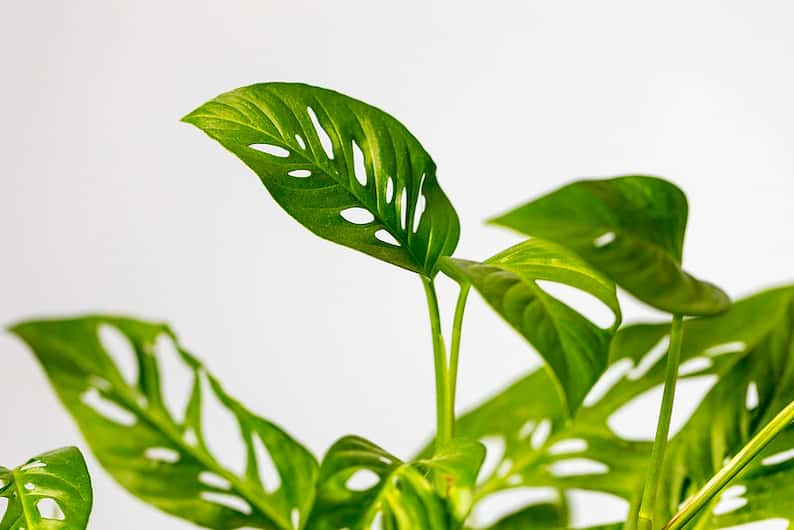
Why are my Monstera adansonii leaves turning yellow?
Yellow leaves on Monstera adansonii are usually a sign of inadequate care and stem from overwatering, underwatering, too little light, too little humidity, or a nutrient deficiency. Identifying the cause of discoloration is the only way to prevent it from spreading and further harming your plant.
If you notice your Monstera adansonii’s leaves turning yellow suddenly, your plant is in ill health. The most common causes are overwatering or too little light, but your best port of call is a full inspection to find what is behind your adansonii’s distress.
Once you have identified the problem, you should treat it immediately. Regulate your watering schedule if that seems to be the cause, or move your plant to a brighter, sunnier position. If neither water nor light appears to be the issue, consider treating your Monstera with a dose of slow-release fertilizer.
Why does my Monstera adansonii have wrinkled leaves?
Curling or wrinkled leaves on a Monstera adansonii are generally related to irregular watering. Too dry, and your adansonii’s leaves will curl and crinkle. Too much water and they will also become wrinkly and potentially turn yellow.
It’s remarkable how your watering practices can affect an adansonii, but also good in a way as how your Monstera’s leaves behave can tell you a lot about your plant’s overall health. Wrinkling is almost always related to water, so check your plant’s soil to feel if it’s too dry or too wet.
If you’re still unsure, invest in a moisture meter. These are readily available at your local nursery or garden center and will help you keep an eye on healthy dampness levels for your adansonii.
